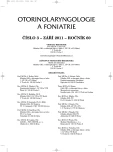-
Medical journals
- Career
Test of Sentence Intelligibility in Babble Noise in Persons with Normal Hearing
Authors: O. Dlouhá; J. Vokřál
Authors‘ workplace: Foniatrická klinika 1. LF UK a VFN, Praha, přednostka doc. MUDr. O. Dlouhá, CSc.
Published in: Otorinolaryngol Foniatr, 60, 2011, No. 3, pp. 125-130.
Category: Original Article
Overview
We developed a new test of sentence intelligibility in noise in the Czech language. This article demonstrates the results of the influence of different noise types on the sentence intelligibility in persons with a normal hearing ability. An evaluation of speech recognition can be provided by a presenting of testing material in a sentence form with a presence of competitive noise. This issue has been treated with a lot of interest abroad, however, in the Czech language these audiological tests have not been compiled and used so far. The babble noise is very often used abroad for its significant interference with speech signal in the time and spectrum domain. The time characteristics of the babble noise are similar to the human voice and therefore it masks more expressively on the central level than the random stable noises. Test of sentence intelligibility in background noise in the Czech language involves 3 decades of sentences. The sentence context was used from a field of normal life and was phonetic balanced. We tested listeners with normal hearing. There are more possibilities in the field of speech audiometry in worsened acoustic conditions.
Key words:
sentence intelligibility in babble noise, new test in Czech language.
Sources
1. Audiometrické vyšetřovací metody - část 3: Audiometrie řečí. ČSN ISO 8253-3. Český normalizační institut, Praha, 1998.
2. Česká slovní audiometrie - CD nosič nahrávky, nahráno na ORL klinice UP v Olomouci pod vedením MUDr. Z. Hložka, 1994.
3. Chermak, G. D., Musiek, F.: Central auditory processing disorders (New perspectives). Singular Publishing Group, Inc. San Diego. London, 1997.
4. Kollmeier, B.: Moderne Verfahren der Sprachaudiometrie. Band 1, Median-Verlag nach Killisch-Horn GmbH, Heidelberg, 1992.
5. Krishnamurthy, N., Ikeno, A., Hansen, J. H. L.: Babble speech: acoustic and perceptual variability. Interspeech 2008, 9th annual conference of the International Speech Communication Association, roč. 15, 2008, s. 1040-1043.
6. Novák, A.: Audiologie. Vyšetřovací technika, diagnostika, léčba a rehabilitace. Unitisk, Praha, 2003.
7. Palková, Z.: Fonetika a fonologie češtiny. Universita Karlova - Karolinum, Praha, 1994.
8. Roeser, R. J.: Roeser’s audiology desk reference. A guide to the practice of audiology. Thieme, New York – Stuttgart, 1996.
9. Wagener, K. C., Brand, T.: Sentence intelligibility in noise for listeners with normal hearing and hearing impairment: Influence of measurement procedure and masking parameters, International Journal of Audiology, roč. 44, 2005, s. 144-156.
10. Wilson, R. H., McArdle, R.: Speech signals used to evaluate functional status of the auditory system. Journal of Rehabilitation Research and Development, roč. 42, 2005, 4, s. 79-94.
11. Wilson, R. H., Cates, W. B.: A comparison of two word-recognition tasks in multitalker babble: speech recognition in noise test (SPRINT) and words-in-noise test (WIN). Journal of the American Academy of Audiology, roč. 19, 2008, 7, s. 548-556.
12. Wong, P. C. M., Jin, J. X. M., Gunasekera, G. M., Abel, R., Lee, E. R., Dhar, S.: Aging and cortical mechanisms of speech perception in noise. Neuropsychologia, roč. 47, 2009, 3, s. 693-703.
Labels
Audiology Paediatric ENT ENT (Otorhinolaryngology)
Article was published inOtorhinolaryngology and Phoniatrics

2011 Issue 3-
All articles in this issue
- Normative Data of Subjective Olfactory Tests for the Czech Population
- Test of Sentence Intelligibility in Babble Noise in Persons with Normal Hearing
- Positron Emission Tomography in ORL Oncology
- Perioperative Monitoring of the Function of Head Nerves in Otorhinolaryngology, Neurootology and Surgery of Cranial Base at the Clinic of ORL and Head Surgery LF UPJŠ a UN L. Pasteur (2000 – 2010)
- Idiopathic and Seemingly Idiopathic Neuralgia of Nervus Trigeminus
- Polyganglionitis Bellʼs Palsy – a Clinical Analysis
- Experience with Local Corticoid Therapy in Eustachian Tube Dysfunctions
- Rare Congenital Neck Anomaly: Aneurysm of the Jugular Vein
- Unusual Coincidence of the Hereditary Angioedema, Systemic Lupus Erythematodes and Tongue Carcinoma
- A Rear Cause of Blindness in a Patient with Nasal Polyposis. Leber’s Hereditary Optic Atrophy of Visual Nerve
- Otorhinolaryngology and Phoniatrics
- Journal archive
- Current issue
- Online only
- About the journal
Most read in this issue- Experience with Local Corticoid Therapy in Eustachian Tube Dysfunctions
- Idiopathic and Seemingly Idiopathic Neuralgia of Nervus Trigeminus
- Rare Congenital Neck Anomaly: Aneurysm of the Jugular Vein
- Polyganglionitis Bellʼs Palsy – a Clinical Analysis
Login#ADS_BOTTOM_SCRIPTS#Forgotten passwordEnter the email address that you registered with. We will send you instructions on how to set a new password.
- Career

